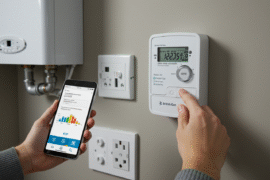This article may contain references to products or services from one or more of our advertisers or partners. We may receive compensation when you click on links to those products or services. Nonetheless, our opinions are our own.
The information presented in this article is accurate to the best of our knowledge at the time of publication. However, information is subject to change, and no guarantees are made about the continued accuracy or completeness of this content after its publication date.
-
Understanding Home Equity Loans and HELOCs for Your Financial Needs
- Quick Comparison of the Two Options:
- Exploring Cash-Out Refinancing and Its Benefits
- What Are the Key Differences Between a Cash-Out Refinance and a HELOC?
- Comparing Costs and Interest Rates of Each Option
- Interest Rates
- Fees and Closing Costs
- How to Decide Which Option Suits Your Goals
- When To Choose a Cash-Out Refinance vs. a HELOC
- Calculating How Much Equity You Have in Your Home
- Understanding the Tax Implications of Tapping Your Home’s Equity
- Practical Tips for Applying for Home Equity Financing
- Maximizing the Benefits of Your Home’s Equity
- Recommended Reads
Voted "Best Overall Budgeting App" by Forbes and WSJ
Monarch Money helps you budget, track spending, set goals, and plan your financial future—all in one app.
Get 50% OFF your first year with code MONARCHVIP
Understanding Home Equity Loans and HELOCs for Your Financial Needs
When exploring your financial options, home equity loans and HELOCs (Home Equity Lines of Credit) can serve as powerful tools to leverage the amount of equity in your property. Home equity loans provide a lump sum amount, often at a fixed interest rate, which you typically pay back over a set term. This can be especially beneficial when you have a specific project in mind, such as home renovations or consolidating high-interest debt. You’re borrowing against the equity you’ve built up in your home, allowing you to access funds quickly without disrupting your financial routine.
On the other hand, HELOCs offer more versatility as they function like a credit line—allowing you to draw on your equity as needed, often at variable interest rates. This means you only pay interest on the amount you actually use. It’s an excellent option for ongoing expenses, such as education or unexpected medical bills.
Quick Comparison of the Two Options:
| Feature | Home Equity Loan | HELOC |
|---|---|---|
| Disbursement | Lump sum | Credit line access |
| Interest Rate | Fixed | Variable |
| Repayment Term | Set term (e.g., 15-30 years) | Flexible (draw period then repayment) |
Deciding between a home equity loan and a HELOC depends on your unique financial situation. Weigh your immediate financial needs, whether you prefer a structured repayment plan or the flexibility of accessing funds over time, and consider which aligns best with your goals. Each option comes with its own benefits that can help you make the most of your home’s value.
Exploring Cash-Out Refinancing and Its Benefits
When considering your financial options, cash-out refinancing can be a powerful tool to access the equity you’ve built in your home. Unlike traditional refinancing, where you simply adjust your current mortgage rate or terms, this approach allows you to take out additional funds based on your home’s current value. You can use this cash for various purposes, from home renovations and debt consolidation to funding education or other major expenses. By leveraging your home equity, you may also secure a lower interest rate than other forms of borrowing, which can translate into substantial savings over time.
One of the key advantages of cash-out refinancing is the potential for tax benefits. Interest paid on a cash-out refinance used to improve your home may be tax-deductible, much like your original mortgage interest. Additionally, since you’re replacing your existing mortgage with a new one, it can offer streamlined financial management and can also be beneficial in terms of tax-deductible expenses.
Key Benefits of Cash-Out Refinancing
- Lower Interest Rates: Often lower than personal loans or credit cards.
- Fixed Payments: Stability with fixed monthly payments over the life of the loan.
- Single Payment Structure: Simplifies budgeting by merging multiple debts into one.
What Are the Key Differences Between a Cash-Out Refinance and a HELOC?
When comparing a cash-out refinance to a Home Equity Line of Credit (HELOC), several key differences emerge that can significantly impact your financial decision. One major distinction lies in the loan structure: a cash-out refinance involves replacing your existing first mortgage with a new, larger loan, allowing you to access cash based on your home’s current value. In contrast, a HELOC operates more like a credit card, providing a revolving line of credit that you can draw from as needed. This flexibility can be particularly advantageous for covering unexpected expenses or ongoing projects.
Another critical difference pertains to interest rates. Typically, cash-out refinancing offers a fixed interest rate, which provides stability in monthly payments over the life of the loan. On the other hand, HELOCs usually come with variable interest rates, meaning your payments can fluctuate based on market conditions. This dynamic can create budgeting challenges if interest rates rise unexpectedly. Understanding these key differences is essential when determining which option aligns best with your financial needs and goals.
Loan Structure
The loan structure is one of the most notable differences between cash-out refinancing and HELOCs. A cash-out refinance replaces your existing mortgage with a new, larger mortgage that is often larger than what you currently owe. This new loan can give you access to a lump sum of cash, which can be used for various purposes, including home improvements or debt consolidation. This option consolidates your debt into a single payment, making it easier to manage.
Conversely, a HELOC functions as a second mortgage, allowing you to borrow against the equity of your home as needed. It provides a revolving line of credit, where you can withdraw funds up to a certain limit during a specified draw period and over a set period of time. This flexibility offers homeowners the ability to access cash incrementally, making it ideal for ongoing expenses or projects without needing to secure a lump sum upfront.
Impact on Mortgage
The impact on your existing mortgage is another crucial consideration when evaluating cash-out refinances versus HELOCs. A cash-out refinance directly alters your current mortgage by replacing it with a new loan that may have different terms, interest rates, and payment schedules, making it a better option under certain circumstances. This could result in a lower interest rate if market conditions have improved since your original mortgage or a higher rate if they have worsened. Additionally, the new mortgage may extend or shorten the repayment term, affecting your overall financial strategy.
In contrast, a HELOC does not change the terms of your primary mortgage. Instead, it operates as an additional type of loan that sits second to your first mortgage. This means you maintain your original mortgage terms while accessing additional funds. However, it’s essential to consider that having multiple mortgages increases your total debt load, which can impact your financial future and borrowing power.
Repayment Terms
When it comes to repayment terms, cash-out refinancing and HELOCs differ significantly. With cash-out refinancing, you begin repaying the entire loan amount immediately, typically with fixed monthly payments that include both principal and interest. This predictable payment structure can aid in budgeting and financial planning, providing peace of mind as you know exactly how much you owe each month.
In contrast, a HELOC operates through two distinct phases: a draw period and a repayment period. During the draw period, you can borrow against your line of credit and may only be required to make interest payments, which can result in lower initial monthly costs. However, once the draw period ends, you enter a repayment period phase where you must repay both principal and interest, leading to potential increases in your monthly payment amounts. This variable payment structure requires careful budgeting and financial management to ensure you’re prepared for the transition.
Comparing Costs and Interest Rates of Each Option
| Option | Average Interest Rate | Typical Fees |
|---|---|---|
| Home Equity Loan | 4%-8% | $500-$2,000 |
| HELOC | 3%-6% | Varies (often minimal) |
| Cash-Out Refi | 3%-7% | $2,000-$5,000 |
When choosing between home equity loans, HELOCs, and cash-out refinancing, understanding the cost implications, including the annual percentage rate (APR), and interest rates is crucial. Generally, home equity loans feature fixed interest rates that range from 4% to 8%, along with upfront costs that may average between $500 and $2,000. This stability appeals to those who prefer predictable monthly payments over a longer duration.
Conversely, a HELOC typically offers lower interest rates (approximately 3% to 6%) and often comes with minimal or no closing costs, making it a versatile option if you require ongoing access to funds. Meanwhile, cash-out refinancing may have similar interest rates (around 3% to 7%) but usually entails higher fees that can reach $5,000 or more. Weighing these costs and assessing your specific financial situation can help you make a more informed decision.
Interest Rates
Cash-out refinancing allows homeowners to access a large sum upfront, while a HELOC provides a revolving line of credit for flexible use. With cash-out refinancing, you receive a lump sum and make monthly payments. Conversely, a HELOC offers a draw period for accessing funds as needed. Cash-out refinancing typically results in a new loan with a fixed interest rate, while a HELOC often has a variable rate. Understanding these differences is crucial to choosing the right option for your financial goals.
Fees and Closing Costs
Cash-out refinancing allows homeowners to access equity as a lump sum with a new mortgage. Benefits include lower interest rates, tax-deductible interest payments, and a fixed repayment period. Contrarily, a HELOC offers a line of credit with variable rates and a draw period. Understanding the key differences in loan structure, impact on current mortgages, and repayment terms is crucial. Comparing costs and interest rates, including fees and closing costs, helps in deciding which option aligns better with financial goals.
How to Decide Which Option Suits Your Goals
Choosing the right financing option depends on your financial situation, goals, and needs. Consider what you aim to accomplish with the funds:
- A one-time lump sum for renovations or debt consolidation? A home equity loan or cash-out refinance might be the best choice.
- Ongoing access to funds for unpredictable expenses? A HELOC offers more flexibility.
Key Factors to Consider
- Interest Rates: Compare the rates for each option; cash-out refinances often offer lower rates.
- Repayment Terms: HELOCs typically have variable rates, while home equity loans offer fixed rates.
- Fees and Closing Costs: Take into account any fees associated with refinancing versus HELOCs and loans.
Review your budget, assess your current financial health, and consider consulting with a financial advisor to make the most informed choice.
When To Choose a Cash-Out Refinance vs. a HELOC
Cash-Out Refinancing allows you to access your home equity by replacing your existing mortgage with a new one for a higher amount. This option is beneficial for obtaining a lump sum upfront, potentially at a lower interest rate than a HELOC. The key differences lie in the loan structure, impact on your mortgage, and repayment terms. Understanding these distinctions will help you decide which option aligns best with your financial objectives.
Calculating How Much Equity You Have in Your Home
Cash-out refinancing lets you access your home equity in a lump sum, usually with a fixed interest rate, making it a suitable choice for needs that arise over a long period. It replaces your current mortgage with a larger one, giving you predictable monthly payments. In contrast, a HELOC works as a line of credit with a variable interest rate during the draw period, allowing you to borrow as needed. Understanding these options and their implications is crucial for choosing the right one to meet your financial goals.
Understanding the Tax Implications of Tapping Your Home’s Equity
Exploring Cash-Out Refinancing involves obtaining a new mortgage loan with an amount higher than the existing loan balance, enabling the homeowner to receive the difference in cash. This option typically offers lower interest rates compared to personal loans or credit cards. The lump sum received can be used for various purposes, such as home renovations or debt consolidation. Cash-Out Refinancing provides a fixed interest rate and predictable monthly payments, making it a favorable choice for those seeking stability in their financial planning.
Practical Tips for Applying for Home Equity Financing
Being well-prepared can improve your chances of securing the best terms. Follow these steps:
- Assess Your Financial Situation: Determine how much equity you have in your home and how much you need.
- Review Your Credit Score: Lenders consider this a crucial factor in determining your interest rate and eligibility.
- Shop Around for Lenders: Compare terms, interest rates, and fees.
- Gather Necessary Documentation:
| Document | Purpose |
|---|---|
| Income Statements | Shows ability to repay the loan |
| Tax Returns | Provides proof of income |
| Property Documents | Verifies ownership and home value |
Maximizing the Benefits of Your Home’s Equity
Understanding the differences between a home equity loan, a HELOC, and cash-out refinancing empowers you to make informed financial decisions.
| Option | Pros | Cons |
|---|---|---|
| Home Equity Loan | Fixed payments, predictable budgeting | Higher fees, potential for foreclosure |
| HELOC | Flexibility, only pay interest on what you use | Variable rates can lead to higher payments |
| Cash-Out Refinance | Lower rates, access larger cash amounts | Closing costs, resets the mortgage term |
Considering your current needs and long-term objectives will help you determine the best way to utilize your home’s equity.

Reviewed and edited by Albert Fang.
See a typo or want to suggest an edit/revision to the content? Use the contact us form to provide feedback.
At FangWallet, we value editorial integrity and open collaboration in curating quality content for readers to enjoy. Much appreciated for the assist.
Did you like our article and find it insightful? We encourage sharing the article link with family and friends to benefit as well - better yet, sharing on social media. Thank you for the support! 🍉
Article Title: HELOC, Home Equity Loan, or Cash-Out Refinance? Choosing the Right Option
https://fangwallet.com/2025/02/10/heloc-home-equity-loan-or-cash-out-refinance-choosing-the-right-option/The FangWallet Promise
FangWallet is an editorially independent resource - founded on breaking down challenging financial concepts for anyone to understand since 2014. While we adhere to editorial integrity, note that this post may contain references to products from our partners.
The FangWallet promise is always to have your best interest in mind and be transparent and honest about the financial picture.
Become an Insider

Subscribe to get a free daily budget planner printable to help get your money on track!
Make passive money the right way. No spam.
Editorial Disclaimer: The editorial content on this page is not provided by any of the companies mentioned. The opinions expressed here are the author's alone.
The content of this website is for informational purposes only and does not represent investment advice, or an offer or solicitation to buy or sell any security, investment, or product. Investors are encouraged to do their own due diligence, and, if necessary, consult professional advising before making any investment decisions. Investing involves a high degree of risk, and financial losses may occur including the potential loss of principal.
Source Citation References:
+ Inspo












































